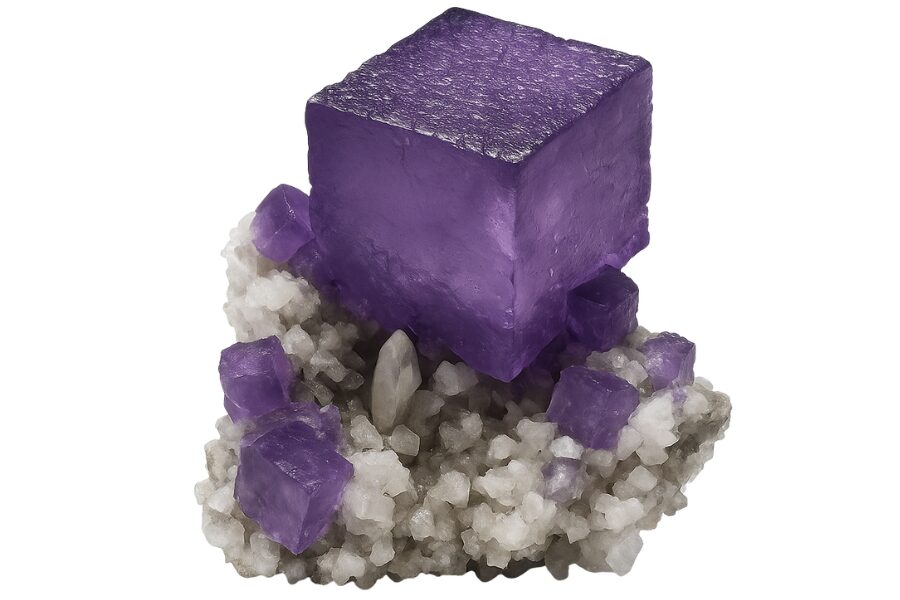The search for crystals in Tennessee starts with learning how the land reveals its hidden minerals. The best discoveries often begin where rock, water, and soil meet.
You might not notice at first, but the state’s varied terrain offers countless places for crystals to surface. Sunlight catching on a fragment of quartz can signal a much larger deposit below.
Exploration becomes more rewarding once you understand the subtle differences in where crystals tend to gather. Paying attention to those small details turns an ordinary walk into a chance encounter with something extraordinary.
When you know where to begin looking, you give yourself the best chance to uncover stones that truly stand out. That kind of awareness can turn a casual day outside into the start of a great personal collection.
- The extensive local experience and understanding of our team
- Input from multiple local crystal hunters and crystal collecting groups
- The accessibility of the crystal mining locations
- Safety and potential hazards when collecting
- Private and public locations
- A desire to include locations for both experienced crystal hunters and those who are just starting out
Using these weights we think we’ve put together the best list out there for those who love finding new crystals for our collections!
The Types of Tennessee Crystals You Can Find
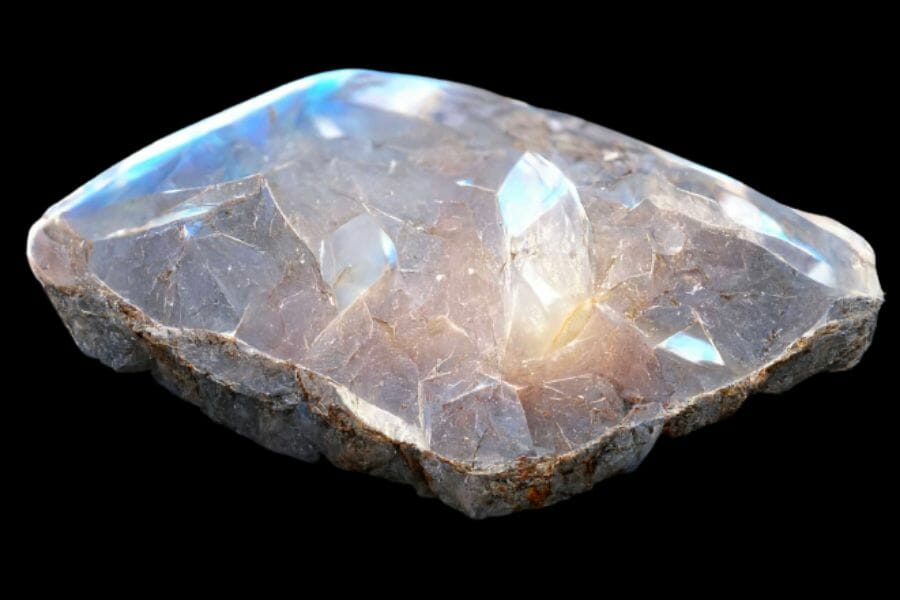
Crystals are renowned for their beauty, with a dazzling array of colors and shapes that can range from delicate and intricate to bold and striking. Tennessee boasts of a diverse variety of crystals that make it an ideal destination for anyone looking to experience the joy of finding them.
Garnet
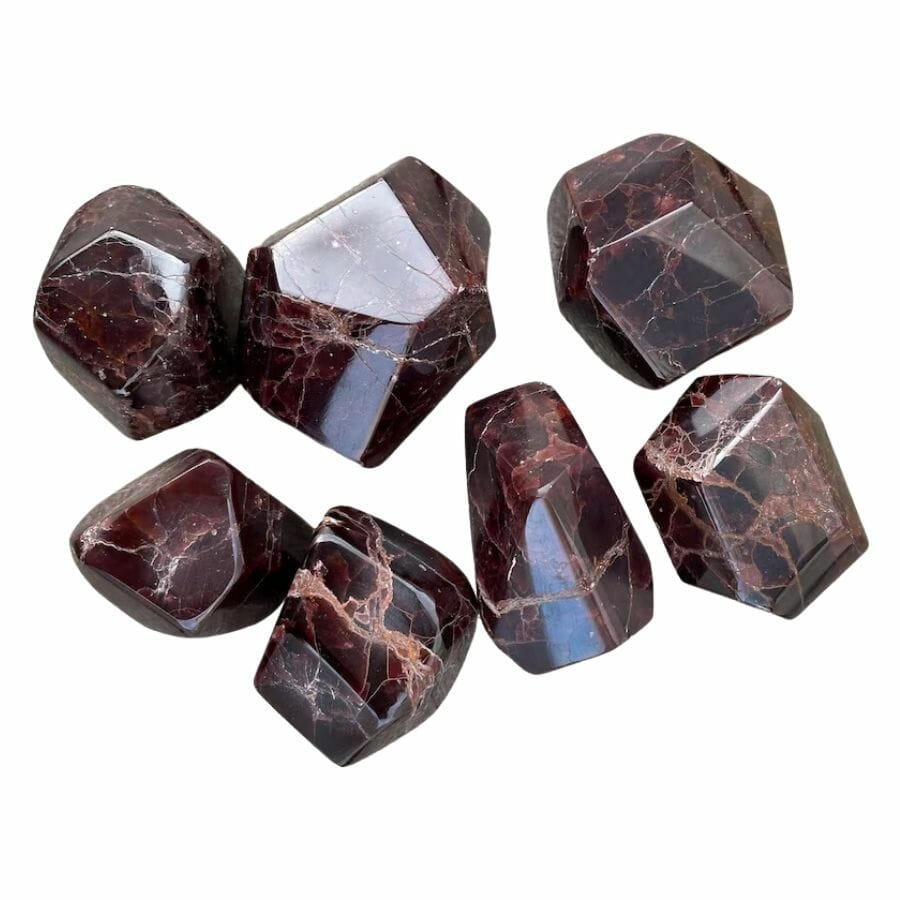
Garnet is an awesome gemstone that comes in many colors, although people often think of it as red. In Tennessee, garnet can be found in various places, and it’s a real treasure for rock lovers!
Now, let’s dive into the cool part – how garnets are formed. Picture this: deep inside the Earth where it’s super hot and packed tight, certain minerals get cozy under high pressure and heat.
Over time, these conditions cause the minerals to crystallize.
Once this happens, garnets start to form! They’re mostly found in metamorphic rocks, which are rocks that have transformed due to heat and pressure.
What makes garnet even cooler is the different types it comes in. The different types are due to the various minerals that combine.
So, you might find red garnets, green garnets, or even orange ones! Each one has its own personality, and rock lovers get really excited to see the differences.
The value of garnet can vary a lot based on its quality, color, and size. Just like with any other rock or gem, the clearer and more vibrant it is, the more valuable it might be.
Aside from its stunning beauty, garnet is also pretty tough. It doesn’t scratch easily, so it’s great for making jewelry. Because of this, people have been wearing garnet jewelry for thousands of years.
It’s also used in industry for things like sandpaper because of its hardness.
Garnet has history, beauty, and strength, all wrapped up in one sparkling gemstone. If you’re in Tennessee and stumble across a garnet, you’ll know you’ve found something that has been created deep inside the Earth, over millions of years.
Where you can find garnet in Tennessee
- Burra Burra Mine, Polk County
- Cherokee Mine, Copperhill
- Old Forge Magnetite Mine, Cranberry Magnetite Mining District
Wavellite
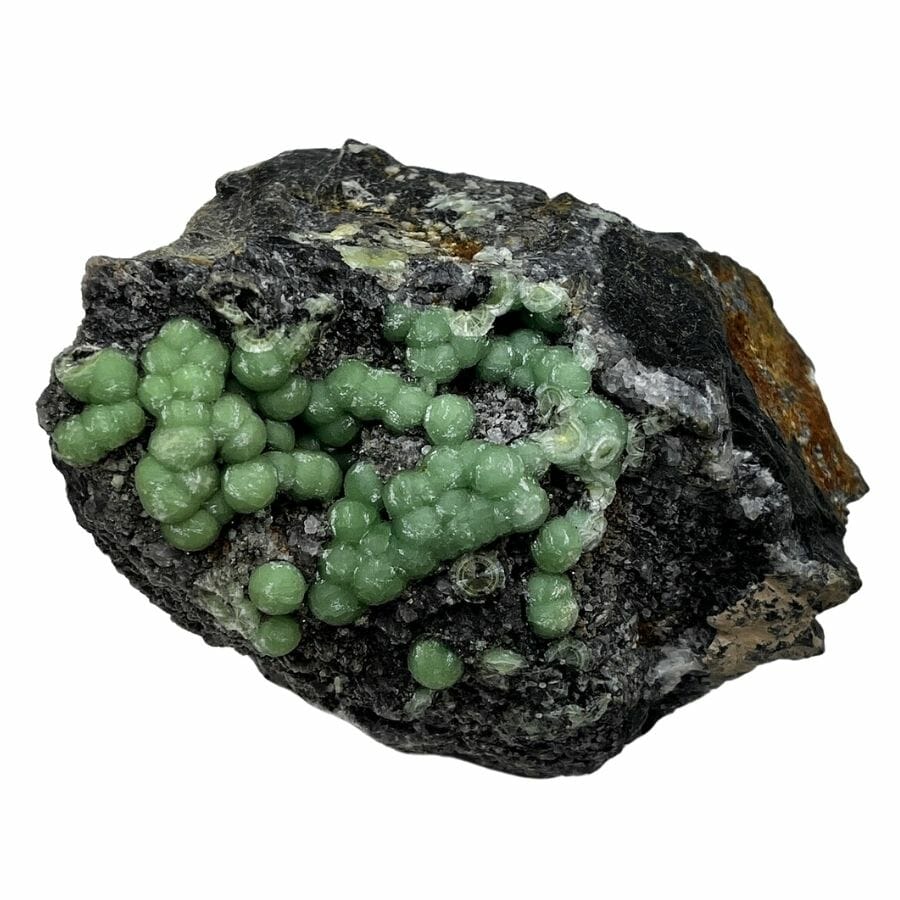
Let’s set our sights on a mineral that’s got a groovy name and looks even cooler: wavellite! This mineral is unique, and its appearance will make your eyes pop.
Imagine a rock surface covered in green, yellow, or even colorless radial clusters that look like little starbursts.
Picture this: there’s a rock with a bunch of tiny holes or cracks in it. Over time, water with special minerals in it flows through these spaces.
As this water slowly drips and leaves the rock, the minerals start forming those unique round patterns that we know as wavellite.
People have a soft spot for wavellite because of its unique patterns. They’re super cool to look at and can make for some pretty unique jewelry or decorations.
Plus, for curious minds, just thinking about how each circle forms from water and minerals is a story in itself.
In the wide world of rocks and minerals found in Tennessee, wavellite has its special place. It’s a testament to the beauty that can form when water, minerals, and a bit of time come together.
Where you can find wavellite in Tennessee
- Wood Mine, Del Rio Mining District
- Sylvia Prospect, Greene County
- Taylor Ridge Manganese Mine, Stony Creek Mining District
Epidote

If you ever come across a green or yellowish-green mineral with a kind of glassy shine, there’s a good chance you’re looking at epidote. Its colors are like the forests of Tennessee in the springtime.
Now, the backstory of epidote is pretty cool. This mineral forms when rocks get exposed to heat and pressure, kinda like when a cake bakes in the oven. Over a long time, certain rocks start to change and transform.
And if there’s enough of the right ingredients, like calcium and iron, they come together to form the sparkling epidote.
That beautiful green color is something to write home about. It’s used in jewelry and collections, and it adds a touch of Tennessee’s natural beauty to any display.
Epidote also has a special way of reflecting light, which makes it sparkle in a unique way.
Geologists also love epidote because it tells a story about the history and conditions of the area where it’s found.
Where you can find epidote in Tennessee
- Teegarden Magnetite Mine, Cranberry Magnetite Mining District
- Chestnut Ridge Magnetite Prospects, Cranberry Magnetite Mining District
- Miller Magnetite Prospect, Walnut Mountain Mining District
Fluorite
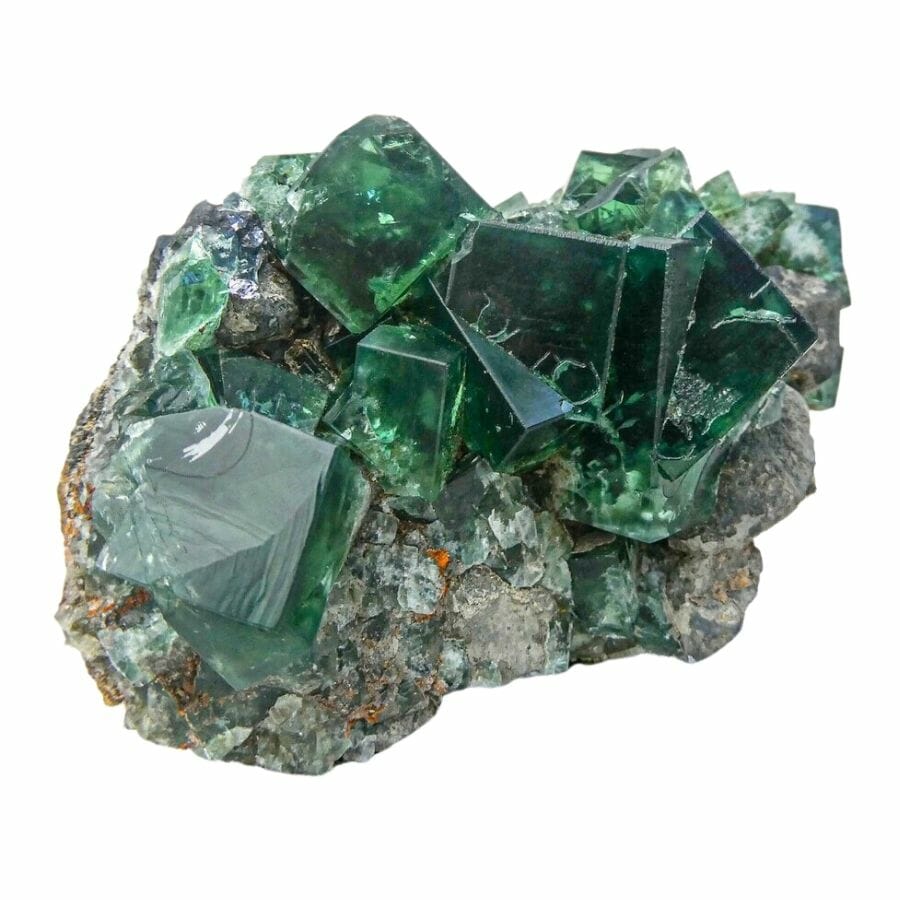
Imagine a mineral that can be clear as glass or as vibrant as the rainbow. That’s fluorite! It comes in so many shades – purple, green, blue, and even yellow. Sometimes, all these colors can be in one single piece.
Deep down in the Earth, there are hot liquids full of different minerals. Sometimes, these hot liquids get into cracks in the rocks, and when they cool down, they leave behind some really cool crystals.
If the conditions are just right, fluorite can form, creating those beautiful colors.
Fluorite is prized for its colors. It’s like having a piece of the sky, grass, and sunshine all in one stone! People love to use it for jewelry and decoration because it’s so pretty. Fluorite also glows under ultraviolet light!
Beyond its beauty, fluorite is also super useful. It’s been mined to help make things like steel and even the fluoride in our toothpaste.
Where you can find fluorite in Tennessee
- Rockway Quarry (Limestone Products Corp.), Colonial Heights
- No. 4 Shaft, Elmwood Mine, Carthage
- Gordonsville Mine, Carthage
Marcasite
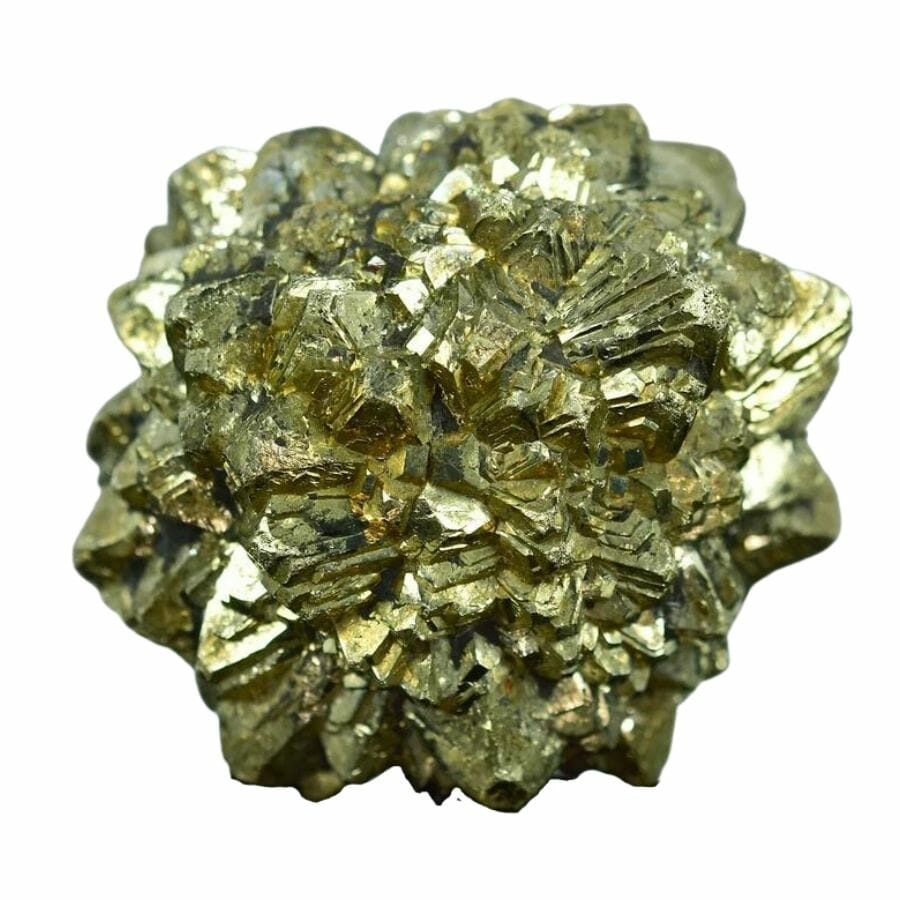
Let’s talk about a real gem: marcasite! If you’ve ever seen shiny, metallic crystals that look like they’re straight out of a fairy tale treasure chest, then you’ve probably seen marcasite.
It has a golden or silver sheen that can sparkle brilliantly, almost like it’s winking at you from the ground!
Now, marcasite isn’t the same as fool’s gold, but it does share a family resemblance. It’s shiny and has a gold-ish, silver-ish look that glimmers in the light.
It forms when iron and sulfur hang out together under the right conditions, deep down in the Earth’s crust. Over time, they bond and create those gleaming marcasite crystals.
Marcasite is quite a big deal because of its sparkle. Many people love to use it in jewelry because it gives that beautiful shimmer without the big price tag of some other gems.
But marcasite isn’t just a pretty face. Scientists and rock lovers also study it to learn about how minerals form and what conditions were like underground in ancient times.
Where you can find marcasite in Tennessee
- Tri-Cities Airport quarry, Sullivan County
- Elmwood Mine, Carthage
- Eve Mills Prospect, Monroe County
Barite
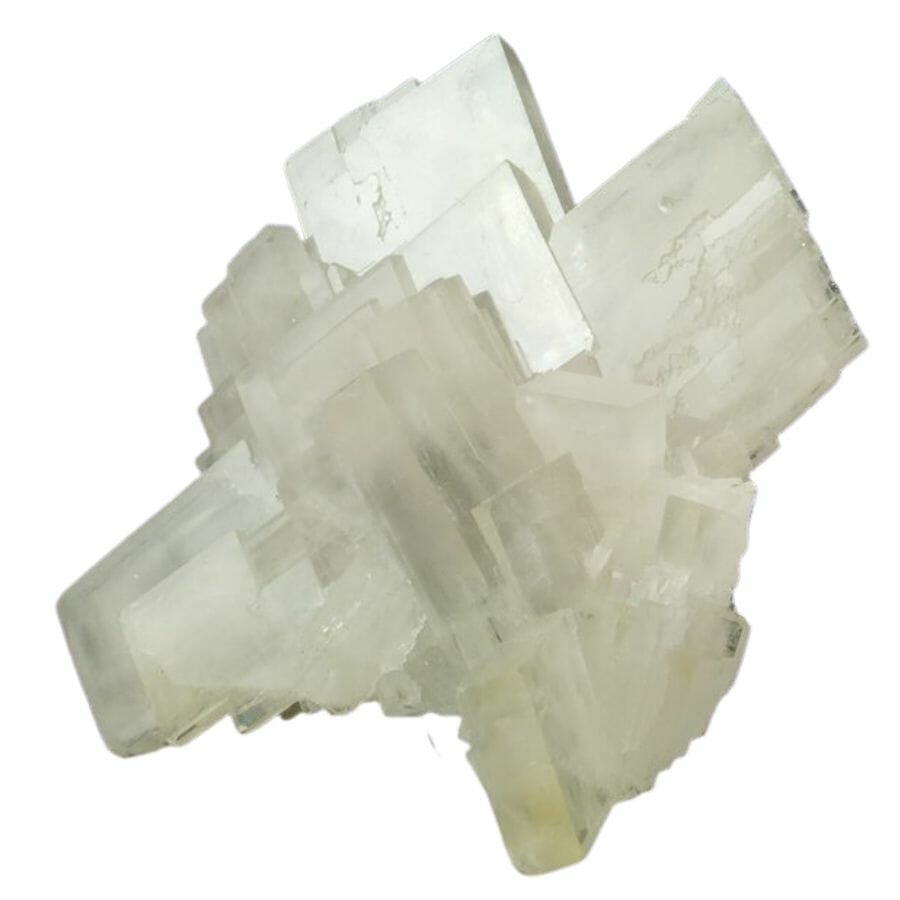
When diving into Tennessee rock identification, one gem you might come across is barite. It can be clear, white, or even take on colors like blue, yellow, and brown. Its crystals come in different shapes and can look like plates or long, pointy spikes.
But the coolest part? It’s heavy for its size. If you ever get to hold a piece, you’ll feel its surprising weight!
Barite forms in some really interesting ways. Sometimes, it grows when hot water that’s been hanging out deep underground mixes with certain minerals. As the water cools down, barite begins to crystallize.
Picture it like sugar crystals forming on a string, but way cooler and underground!
Of course, this mineral barite isn’t just cool to look at. It has some super handy uses, too! People grind it up to put in things like paint, rubber, and paper. It gives products weight and helps them stay sturdy. Plus, it’s even part of the process for drilling oil.
Where you can find barite in Tennessee
- Lost Creek Barite Mine, Clinch Valley Area
- Ballard Mine, Sweetwater Barite Mining District
- Williams Mine, Del Rio Mining District
Cerussite
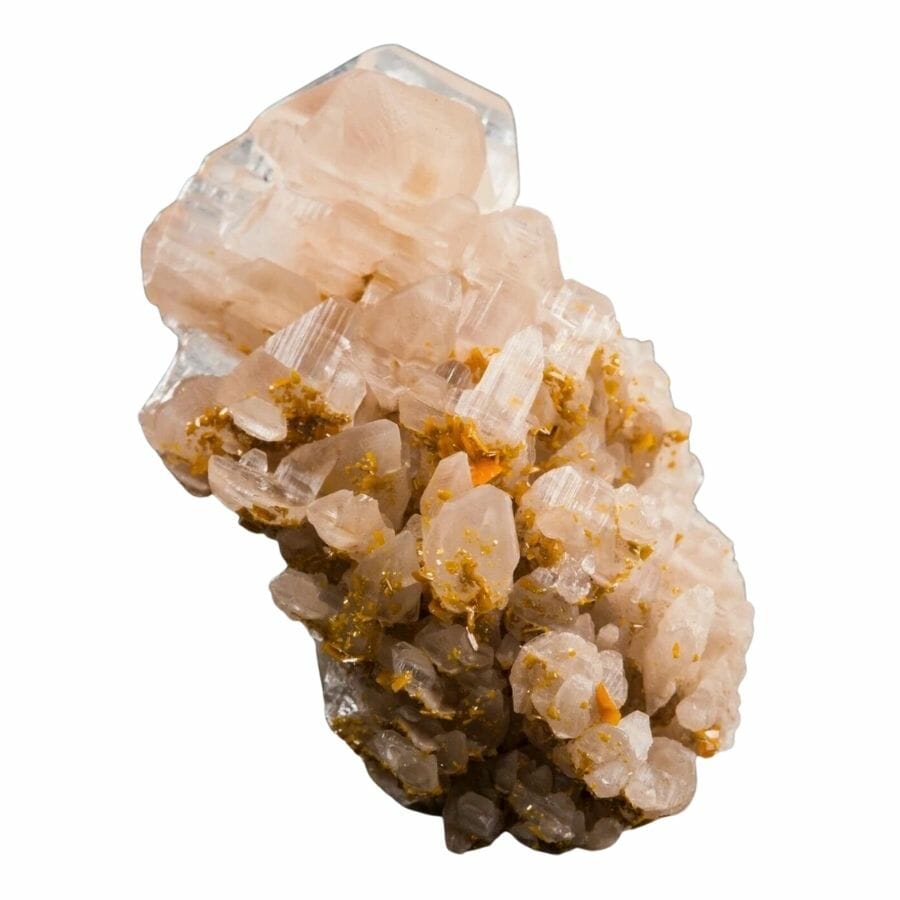
Cerussite sounds like a fancy name, and its looks live up to it. It’s often clear or white, but can sometimes appear gray or even tinted with shades of green or blue.
When light hits it just right, cerussite can sparkle and shimmer, making it a treat for the eyes!
The journey of cerussite starts deep within the Earth. It forms when certain rocks rich in lead start to break down. When lead gets together with carbon and oxygen, they create this beautiful mineral.
Collectors and scientists alike value cerussite for its beauty and its unique properties. Its sparkle makes it attractive for jewelry and decoration.
But it’s not just a pretty face; cerussite also tells the story of the land it came from, like a geological diary filled with secrets of the past.
Beyond its beauty, cerussite has a rich history in the world of minerals. Back in the day, people discovered they could get lead from it, which had tons of uses, from making pipes to crafting bullets.
Nowadays, while we might not use cerussite for lead as much, it’s still treasured by collectors and rock enthusiasts for its beauty and significance.
Where you can find cerussite in Tennessee
- Felknor mine, White Pine Mining District
- Bumpus Cove mining district mines
Smithsonite
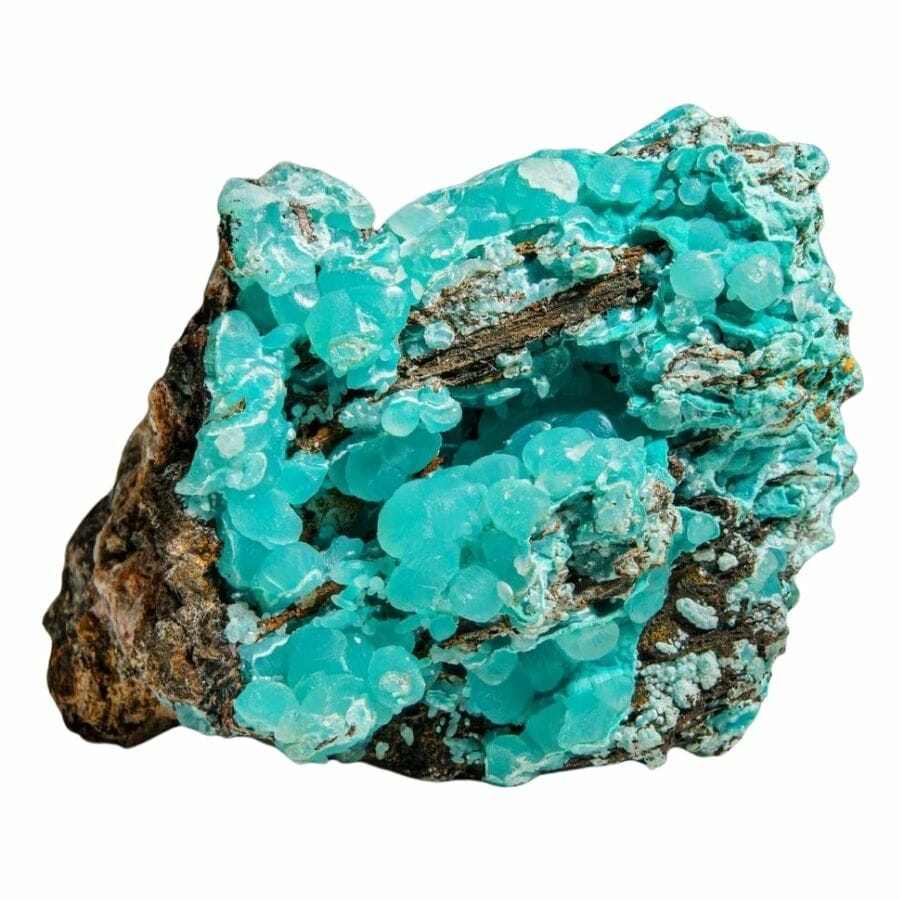
Smithsonite might not be a mineral that everyone’s heard of, but once you get to know it, you’ll see why it’s something special.
Imagine a mineral that’s smooth to the touch, kinda like bubblegum, but much harder and way more dazzling.
Smithsonite can be pink, green, blue, or even yellow. Sometimes, it can shimmer like the surface of a calm pond catching the morning sun.
Smithsonite’s origins is a fun story of transformation. When zinc ore, the stuff deep in the Earth that contains zinc metal, gets exposed to the air and rainwater, a change happens.
This mixture reacts with the zinc ore, and over time, the once ordinary rock changes into the beautiful smithsonite.
This mineral has been spotted in some of Tennessee’s coolest caves and rocky areas. It’s rich in zinc, which is super useful in things like batteries, metal coatings, and even some medicines.
That means this sparkling stone is more than just eye candy; it’s a hard worker, too!
In the grand collection of crystals found in Tennessee, smithsonite is a standout star. Its dazzling colors, interesting formation, and valuable uses make it a real treasure.
Where you can find smithsonite in Tennessee
- Watauga Point zinc prospect, Hampton Mining District
- Rock Quarry Hollow Zinc Mine, Washington County
- Tipton Prospect, Greeneville Mining District
Azurite
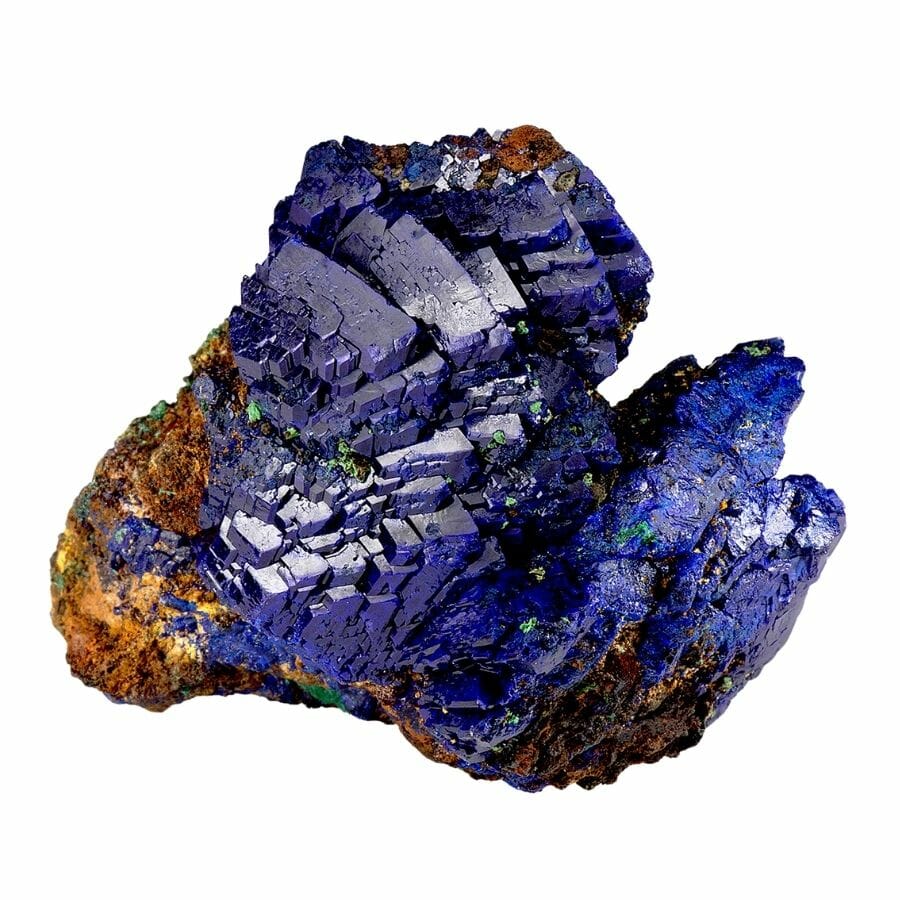
If the sky had a twin in the rock world, it would be azurite. This gem boasts a deep, dreamy blue that can make you think of a vast ocean or a midnight sky.
Let’s unravel the mystery of how azurite comes to be. Picture copper minerals in the ground, just hanging out. When water carrying oxygen and carbon dioxide passes by these minerals, it reacts with them.
This reaction, over time, results in the creation of azurite. With the right conditions, nature can turn basic minerals into something as stunning as azurite!
Azurite’s rich blue hue is a showstopper. Throughout history, people have crushed azurite to use its vibrant color in paints and dyes.
Besides being a natural pigment, azurite is also a hit among jewelry and gem collectors. Its mesmerizing color makes any piece stand out.
Plus, some folks believe azurite helps enhance intuition and awareness.
In the grand rock collection of Tennessee, azurite shines like a sapphire star. It’s a blend of Earth’s chemistry and artistry.
Where you can find azurite in Tennessee
- Ducktown Mining District, Polk County
- Baker Hill, Livesay Mills
Celestite

If you’ve ever seen a piece of celestite, you know it’s like holding a tiny piece of the sky. This mineral has this dreamy blue color that can remind you of a clear summer’s day in Tennessee.
Now, let’s dive into how celestite is formed. Picture water deep underground, filled with minerals. As the water moves through rocks, it leaves behind certain minerals that begin to join together.
Over time, they form crystals. These crystals then grow bigger and bigger, giving us the sparkling celestite we see.
Celestite’s soft blue glow is a real eye-catcher. It’s perfect for jewelry and decorations, adding a touch of Tennessee’s natural beauty to your home.
But celestite’s charm goes beyond its looks. Some people believe that celestite has calming properties, and they use it to create peaceful spaces.
In the grand landscape of Tennessee’s mineral wonders, celestite shines brightly. It’s a testament to the amazing things that happen deep down in the Earth. Every chunk of celestite is a tale of time, water, and Earth’s geological processes.
Where you can find celestite in Tennessee
- Van Buren County Highway Department quarry (Pit No. 394), Spencer
- Nashville Quarry, Davidson County
- Buffalo Cove Quarry, Buffalo Cove
Selenite

Let’s shine a spotlight on selenite, a mineral that looks like it’s straight from a fairy tale! Selenite is a form of gypsum, and it has a soft, glowing appearance that makes it look like moonlight trapped in a rock.
Imagine this: water filled with minerals is moving through the ground. As this water evaporates, the minerals get left behind and start to bond together. Slowly but surely, these minerals begin to create crystals.
If the conditions are just right, those crystals grow into the beautiful, shiny selenite we know and love.
Selenite’s appearance is simply mesmerizing. Its long, clear crystals can look like shimmering wands or delicate angel wings. It’s no wonder that people are drawn to it like moths to a flame!
Many folks love to use selenite in their homes for decoration, or even in their gardens. It adds a touch of natural wonder wherever it goes.
But there’s more! Selenite is also popular in the world of healing. Some people believe it can bring calmness and clarity to a busy mind.
Whether you’re admiring its glow or enjoying its soothing vibes, selenite has a special way of speaking to the heart.
Where you can find selenite in Tennessee
- Marion County quarries
Galena
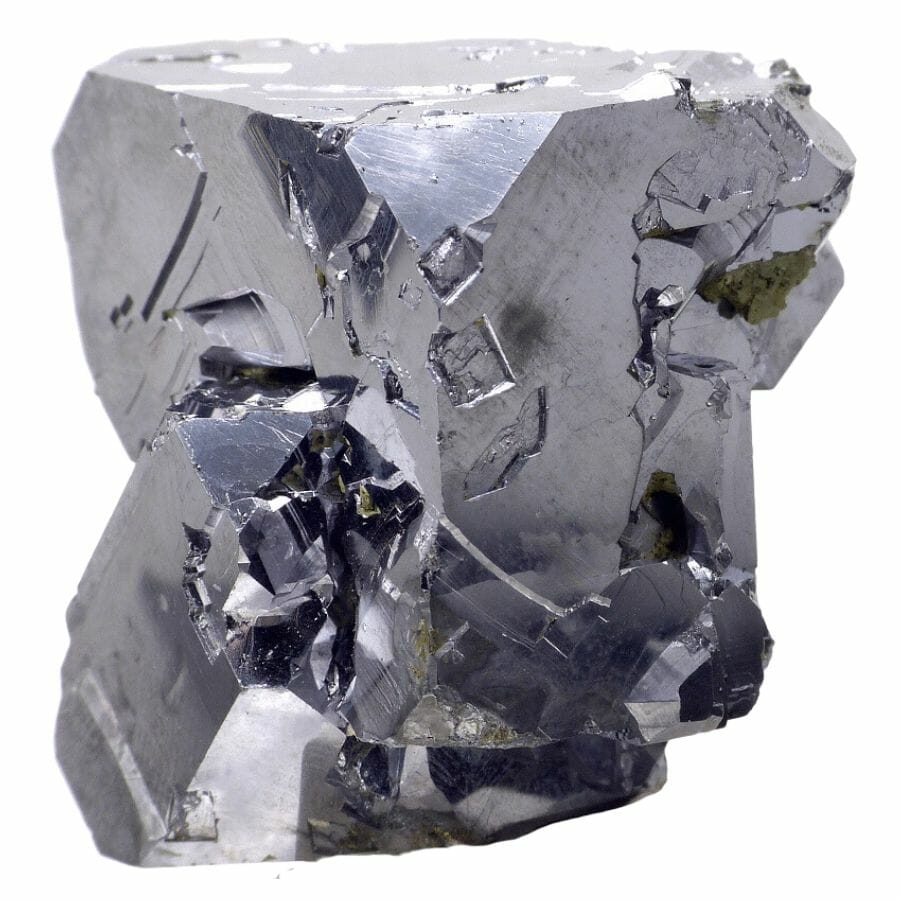
Among the beautiful crystals found in Tennessee, galena is one that deserves special mention. With its shiny metallic luster and cool cube-like shapes, galena has a unique charm that’s hard to miss.
Galena is made up of lead and sulfur. It forms in clusters of shiny silver cubes that are both fascinating and beautiful to look at. These cube shapes form as the galena cools and crystallizes deep underground.
This mineral is usually found in places where hot fluids flow through the cracks and spaces in rocks. These fluids carry minerals like lead and sulfur, and when they meet the right conditions, they come together to form galena.
Galena’s sparkle makes it a favorite for rock collectors. But it’s not just a pretty face. Galena is a big deal because it’s the most important ore of lead.
That means we can get lead from it, which is used in batteries, shields against X-rays, and lots of other things.
Additionally, galena has another surprise up its sleeve: silver! Yes, some galena rocks also contain silver, making them even more valuable.
Where you can find galena in Tennessee
- Gordonsville Mine, Carthage
- Wilder Hollow Prospect, DeKalb County
- Felknor Mine, White Pine Mining District
Calcite
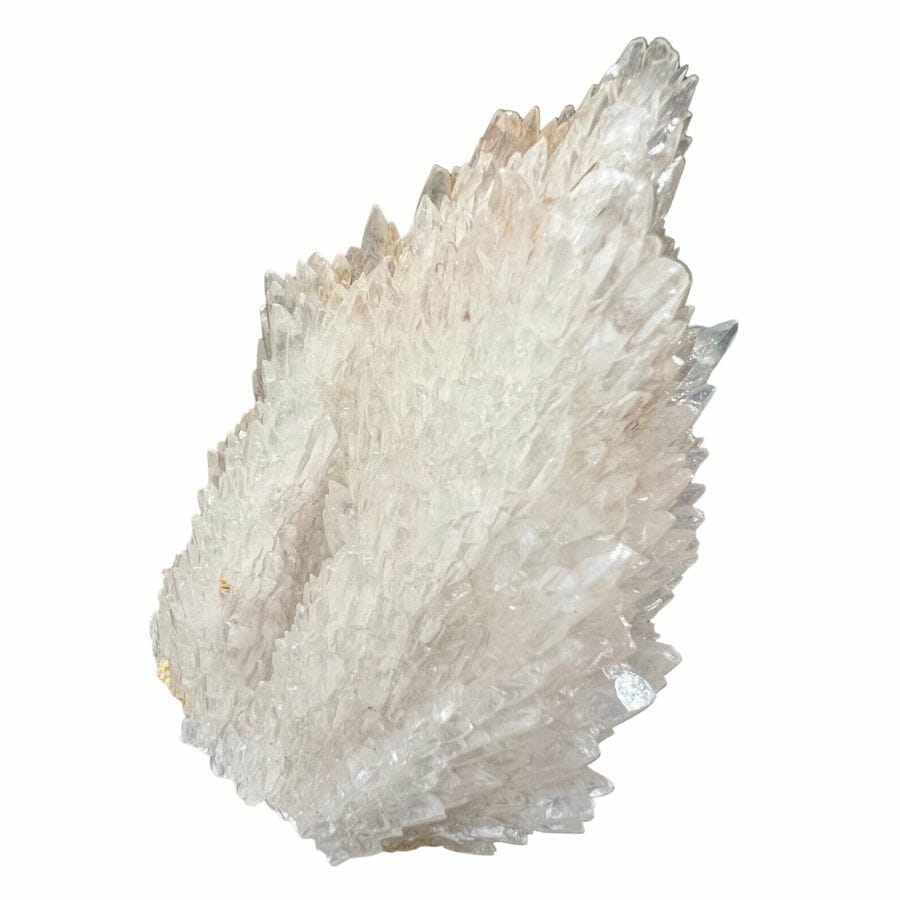
Calcite is one of those awesome minerals that you might stumble upon in the great state of Tennessee. It’s pretty common but no less exciting! Calcite comes in a whole range of colors, like white, yellow, red, and even blue.
It’s a mineral that’s mostly made up of calcium carbonate. That might sound like a mouthful, but it’s something you can find in things like seashells.
Calcite forms in different ways. It can come from the shells of tiny sea creatures that lived millions of years ago, or it might form from hot, mineral-rich waters that move through the cracks in rocks.
Over time, these minerals build up and create beautiful calcite crystals.
Because calcite is a carbonate, if you put a drop of acid on it, it’s going to fizz. This helps identify it among other rocks and minerals.
Calcite has a sparkling appearance and the way it can split light into beautiful rainbows make it a favorite for collectors.
It has a property where it can split light into two rays, making objects behind it look double. This is called “double refraction.”
But it’s not just pretty to look at. Calcite is used in all sorts of everyday things like toothpaste and even cement for buildings. It’s also used in making steel. Because of this, calcite is one of the most valuable rocks in Tennessee.
Where you can find calcite in Tennessee
- Elmwood Mine, Carthage
- Kingsport, Sullivan County
- Buck Miller Mine, Monroe County
Pyrite

Pyrite’s got a nickname that you might have already heard: “Fool’s Gold.” It’s got that shiny, gold-like sparkle that can make people think they’ve hit the jackpot. But don’t be fooled; though it’s not real gold, pyrite is a treasure in its own right.
This mineral is a combination of iron and sulfur, and it forms in a variety of ways. Sometimes it grows around organic material in layers of clay or shale, and other times it forms in the cracks of rocks where hot fluids move through.
These fluids carry minerals that build up and crystallize into pyrite. The result is stunning, metallic crystals that can be shaped like cubes or other cool forms.
Aside from its dazzling appearance, pyrite has been used in all sorts of ways. In the old days, pyrite was struck against flint to create sparks for starting fires. It’s also been used in making batteries, and, believe it or not, even some types of paper!
But for many, the real joy of pyrite is in its natural beauty. Collectors and rock lovers prize pyrite’s unique, shiny appearance, and its surprising shapes.
Where you can find pyrite in Tennessee
- Edwin Patrick Farm Prospect, Hardeman County
- Shiloh Prospect (Ledford Prospect), Copper Ridge Mining District
- Wilder Hollow Prospect, DeKalb County
Quartz
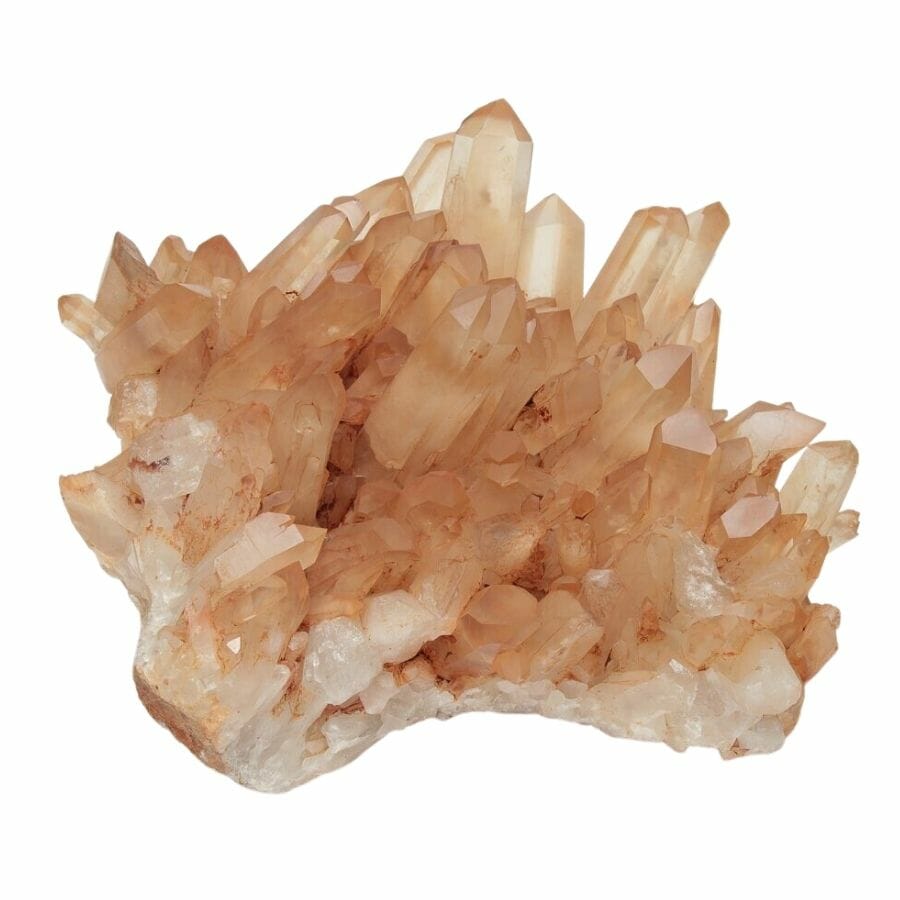
Quartz is one of those rocks that’s as amazing as it is common. You can find it all over the place, including in the beautiful state of Tennessee.
Quartz is made up of silicon and oxygen. When these two get together in the right way, they form crystals that are clear as glass.
But that’s not the only way you’ll find quartz. Sometimes, other minerals join in and give quartz different colors like purple, yellow, or even pink. That’s how you get varieties like amethyst or citrine!
The formation of quartz can happen in a bunch of ways. Sometimes, it forms when hot, watery fluids flow through rocks and leave behind minerals that turn into quartz crystals.
Other times, it grows slowly as other rocks melt away around it. The cool thing is that these different ways of forming give quartz all sorts of shapes and sizes.
This mineral is gorgeous to look at. People make jewelry out of it, and collectors love to have pieces of quartz on their shelves.
But it’s not just pretty; it’s also super useful. Quartz is used in electronics like watches and computers because it can help keep time really accurately.
Where you can find quartz in Tennessee
- Hambright Mine (Lord Mine), Red Hills Mining District
- H. N. Johns Prospect, Copper Ridge Mining District
- J. T. Burns Prospect, Laconia
Hematite
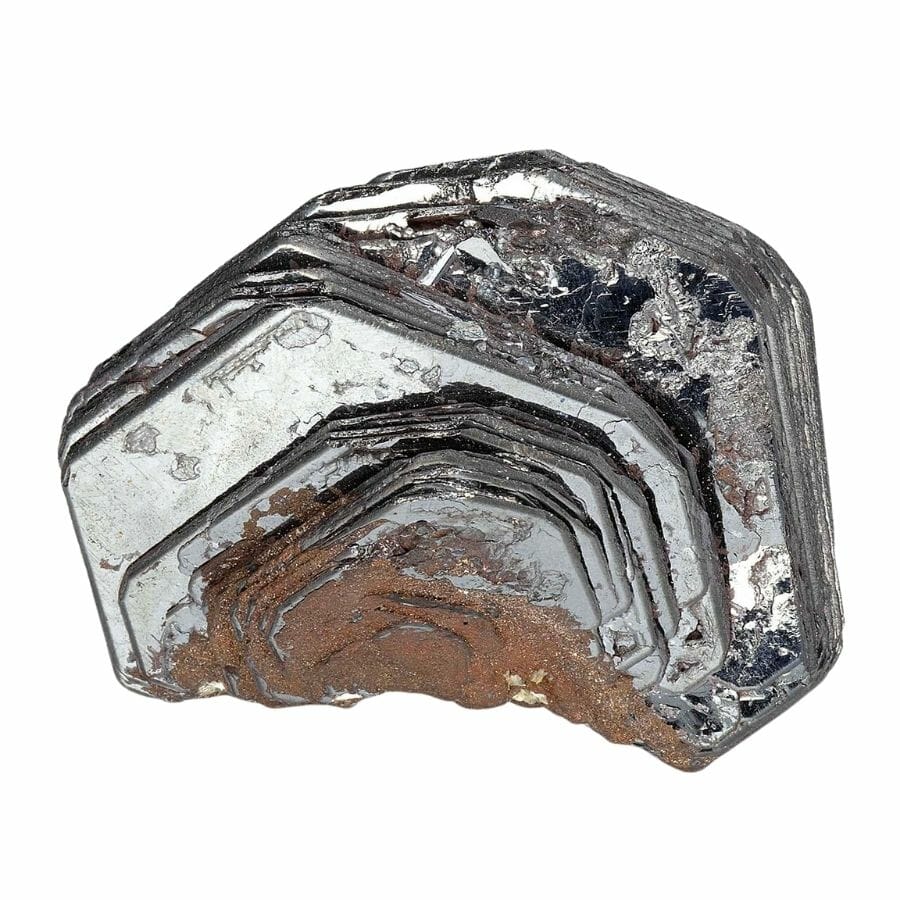
Hematite is one of those super cool minerals that’s not only amazing to look at but also has some interesting stories to tell. You might find this mineral right here in Tennessee, and it’s worth knowing about!
Hematite is often a silvery, shiny gray, or even a reddish-brown. It has a metallic look that’s just out of this world.
But here’s where it gets even more fascinating: if you crush it into a powder, it turns a bright red color. Some people even say it looks like blood. That’s why it’s called hematite, from the word “haima,” meaning blood in Greek.
It’s mostly made of iron and oxygen and forms in places where there was once standing water, like ancient lakes or hot springs. Over time, as the water evaporates, the minerals left behind come together to create hematite.
Aside from looking awesome, hematite is really important in our everyday lives. It’s a key source of iron, which we use to make things like cars, bridges, and buildings. It’s strong and tough, just like the rock itself!
Hematite is also used in jewelry and artwork. Some people even think it has special healing properties, helping to make you feel more grounded and calm.
Where you can find hematite in Tennessee
- Memphis Pit, Shelby County
- Hambright Mine (Lord Mine), Red Hills Mining District
- Blockhouse Iron Prospect, Blount County
The Best Locations For Crystal Mining in Tennessee
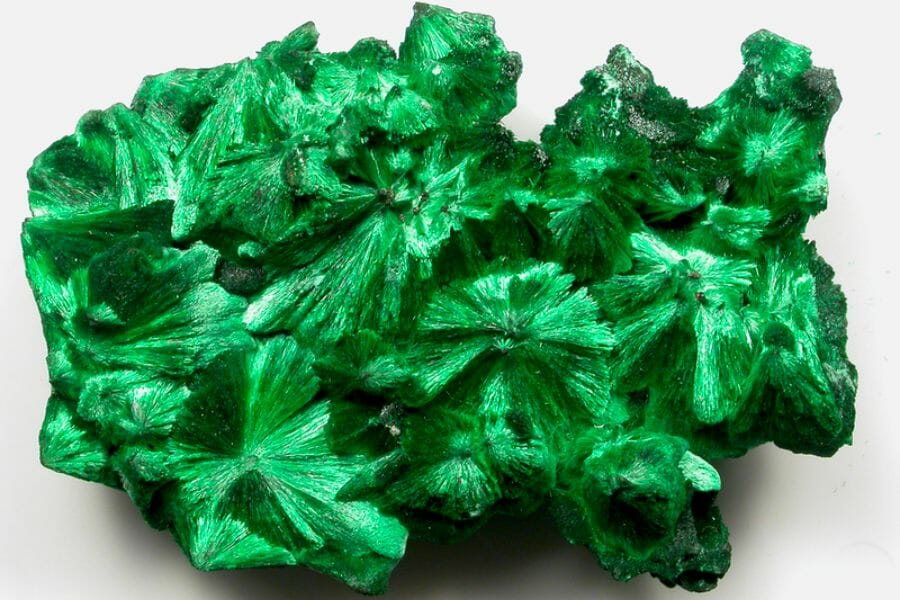
We’ll share with you first our top recommended places to find crystals in Tennessee. Our criterion for selecting them: fun and success at getting our hands on crystals!
Always Confirm Access and Collection Rules!
Before heading out to any of the locations on our list you need to confirm access requirements and collection rules for both public and private locations directly with the location. We haven’t personally verified every location and the access requirements and collection rules often change without notice.
Many of the locations we mention will not allow collecting but are still great places for those who love to find beautiful rocks and minerals in the wild without keeping them. We also can’t guarantee you will find anything in these locations since they are constantly changing.
Always get updated information directly from the source ahead of time to ensure responsible rockhounding. If you want even more current options it’s always a good idea to contact local rock and mineral clubs and groups
Horse Mountain in Silvertooth Agate Fields is Our Favorite Crystal Mine in Pennsylvania

Bedford County, AZ
Horse Mountain in the Silvertooth Agate Fields is a real gem for crystal hunters, it’s even a great place to find gems in Tennesse. The fields were discovered in the 1960s and have been a popular destination for rockhounds ever since. In fact, it was once owned by a famous rockhound named Herschel Silvertooth, hence the name.
The mountain is located in the central part of our stte, near the small town of Altamont. It’s known for its rugged terrain with steep hills and rocky outcrops. The geology of the area is also quite interesting, with layers of sedimentary rock that have been exposed by erosion over time.
Why is this a good place to find crystals? Well, the Horse Mountain in particular is known for its Agates. But don’t be fooled, because Agates are not the only crystals you can find here. There are plenty others! So if you’re planning a trip here, make sure to come prepared because you’ll be in for some adventure.
Where we found crystals at Horse Mountain
If you’re in this place, there’s a high chance you are near crystals already! That’s because you can find them in the different nooks and crannies of this location.
If you want REAL results finding incredible rocks and minerals you need one of these 👇👇👇
Finding the coolest rocks in isn’t luck, it's knowing what to look for. Thousands of your fellow rock hunters are already carrying Rock Chasing field guides. Maybe it's time you joined the community.
Lightweight, mud-proof, and packed with clear photos, it’s become the go-to tool for anyone interested discovering what’s hidden under our red dirt and what they've already found.
Join them, and make your next rockhounding trip actually pay off.
What makes it different:
- 📍 Find and identify 140 incredible crystals, rocks, gemstones, minerals, and geodes across the USA
- 🚙 Field-tested across America's rivers, ranchlands, mountains, and roadcuts
- 📘 Heavy duty laminated pages resist dust, sweat, and water
- 🧠 Zero fluff — just clear visuals and straight-to-the-point info
- ⭐ Rated 4.8★ by real collectors who actually use it in the field
Little Tennessee River
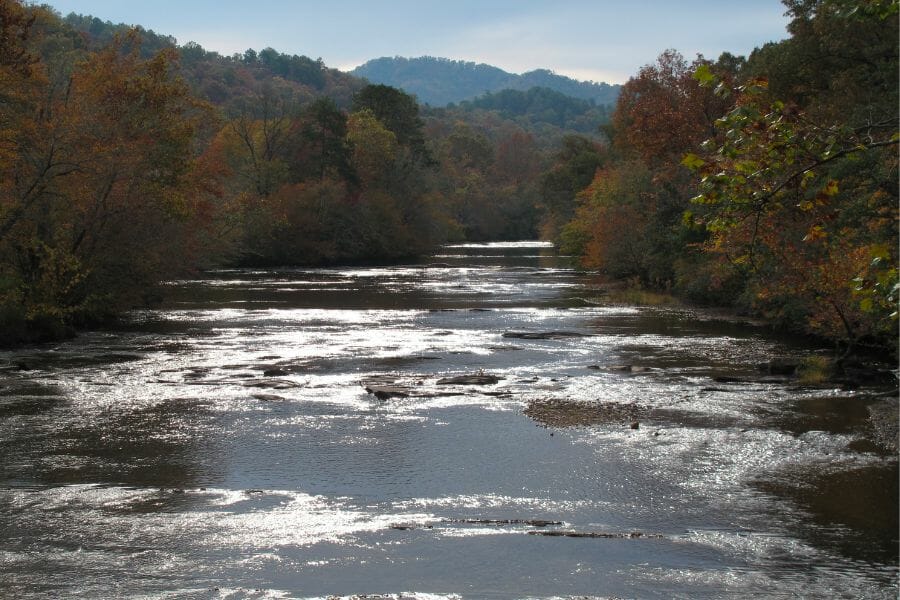
Lenoir City, TN
Little Tennessee River has been an important location for native peoples for thousands of years. The Cherokee, in particular, relied on the river for food, transportation, and trade. Today, it’s still an important part of the local economy and culture.
The river runs through the western part of North Carolina and eastern Tennessee, and is known for its clear, cold water and rocky bottom. The area is quite unique with a mix of ancient rock formations and more recent deposits from the last ice age.
The rocky bottom of the river is a great place to search for a variety of crystals. Many of these have been washed down from the surrounding mountains and deposited here. You can find them by sifting through the sand and gravel on the river bottom or by using a snorkel and mask to search for them underwater.
Where we found crystals at the Little Tennessee River
We had the best luck finding Quartz crystals and other crystals in the red clays of the Little Tennessee River, so we recommend you explore it too. Read more about crystals’ prices in this article.
Cannon County
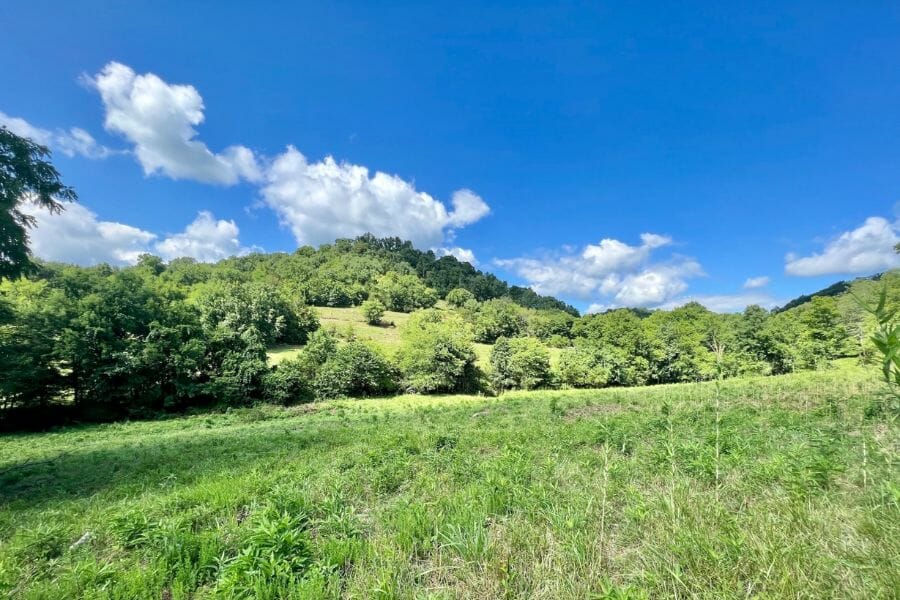
Cannon County, TN
Cannon County was once home to the Native American tribes, including the Cherokee, who used the land for hunting and farming. Located in the central part of our state, it is known for its rolling hills and dense forests.
The county has a mix of limestone, shale, and sandstone formations that have been exposed over time by erosion and weathering. Because of this, it has been known to be rich with different types of crystals that come in a variety of shapes, colors, and sizes.
If you’re planning a trip to Cannon County, you’ll need a rock hammer, chisels, and safety glasses, as well as sturdy shoes and plenty of water. And as always, be respectful of the environment and follow any rules or regulations of the county.
Where we found crystals in Cannon County
If you’re here, then you’re in luck because pretty much the entire county is loaded with crystals! If you want to focus your efforts to find crystals here, you can search in all regional gravels, streams, fields, cliffs and bluffs, road cuts, and quarries for beautiful specimens of crystals like Calcite, Fluorite, Pyrite, and Celestite.
Ben Lomond Mountain

Shellsford Rd. McMinnville TN 37110
Ben Lomond Mountain has been an important location for people in our state for centuries. It was once home to the Cherokee tribe, who used the mountain for hunting and gathering resources. Today, it’s a popular destination for outdoor enthusiasts, including crystal hunters like ourselves!
As part of the Cumberland Plateau, the mountain is known for its rugged terrain, dense forests, and stunning views. Its interesting geology is a mix of sedimentary, metamorphic, and igneous rock formations.
When visiting here, make sure to come prepared with the right equipment and tools. This is not to only ensure your success at finding crystals here, but to also help ensure the sustainability of responsible collecting in this area.
Where we found crystals at Ben Lomond Mountain
If you explore the West slope of Ben Lomond Mountain, you can find stunning samples of Calcite, Celestite, Marcasite, and Pyrite crystals.
Copperhill
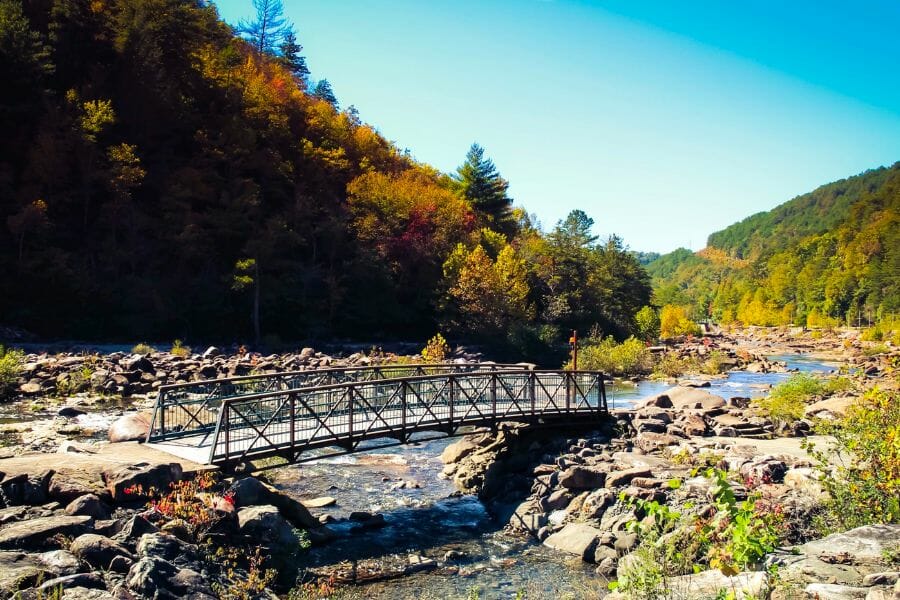
Copperhill, TN
Nestled in the southern part of our state, Copperhill is home to some of the best crystal hunting grounds you’ll ever come across. Copper mining was the main industry in this place for many years, and it’s no surprise that this activity led to the discovery of numerous minerals and crystals in the area. The copper mining operations have since closed down, but the abundance of crystals and minerals remains.
This area is located at the base of the Appalachian Mountains, which have been known to produce some of the most stunning crystals in the world. The mountains themselves are composed of a wide range of minerals.
That being said, Copperhill is undoubtedly a crystal hunter’s paradise!
Where we found crystals at Copperhill
We had the best luck finding beautiful Tennessee crystals at the area stream gravels of this place. When you’re here, you have the chance to get your hands on Azurite, Chalcopyrite, Galena, Garnet, Pyrite, Malachite, and Quartz crystals.
Our Other Favorite Places For Crystal Hunting
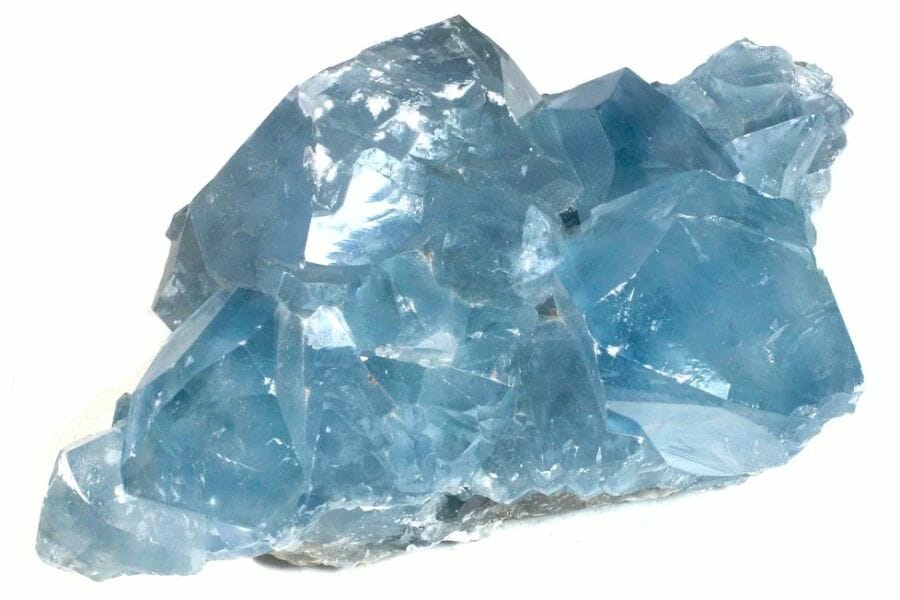
If you’re in for more crystal mining adventure, we have many other recommended places for you. After all, a state as bountiful in natural wonders as ours will not easily run out of areas to explore. In fact, some of these areas are also great for finding Tennessee geodes.
Where you can find crystals for free in Tennessee
In most cases, the best places to search for crystals require some fee. But this is NOT the case always. There are actually a ton of areas that are free to search through. Here are some of them:
| County | Location |
| Bedford | 6 miles east on SR-64 at the Velmer Curvow Farm |
| Blount | In road cuts and stream gravels of Townsend |
| Campbell | Regional road cuts along US 25W to La Follette |
| Fentress | North side of Boles Creek and 1 mile from the church |
| Grundy | South of city in road cuts of Monteagle area |
| Hawkins | County wide in all road, railroad, stream cuts, and also in quarries |
| Overton | A quarry northwest 4 miles near Allons and west of Rte. 52 |
| Putnam | 2 miles on US-70N at abandoned quarry |
| Robertson | Area road cuts and stream gravels |
| Shelby | At Richardson’s landing, area dredging operations, stream gravels and banks |
| Washington | At the Boone Tree Quarry of Johnson City |
| White | At the White Company limestone quarry |
Other great places to dig for crystals
If you have no qualms paying for certain fees to dig for crystals, then here are the great areas that you can visit here. Take note that fees may vary (or may even be waived) depending on the season, so reach out first before heading out to these places.
| County | Location |
| Bradley | Area mines of Cleveland and Mineral Park |
| Clairborne | Lead mine on Lake Norris and area mines of Straight Creek district |
| Cocke | Area mines of Del Rio and at the Gulf Fork Mines |
| Davidson | To the Haysborough lead mine |
| Greene | North 3 miles to ½ miles north of the Moshein-Albany crossroads, then W on gravel road to Gethsemane School, north ½ mile on dirt road to the Brown-Tipton Mine |
| Monroe | East 5 miles, near village of Rocky on road to Vonore, the Bullard Barite Mine |
| Polk | Area mines of Copperhill and Ducktown |
| Sevier | 3.5 miles east at the Nuns Cove mines |
| Smith | At the Elmwood Mine, Foley Mine, and area mines of Trousdale |
| Unicoi | Bumpus Cove area mines |
| Williamson | Nolensville area mines |
How to find crystals in Tennessee
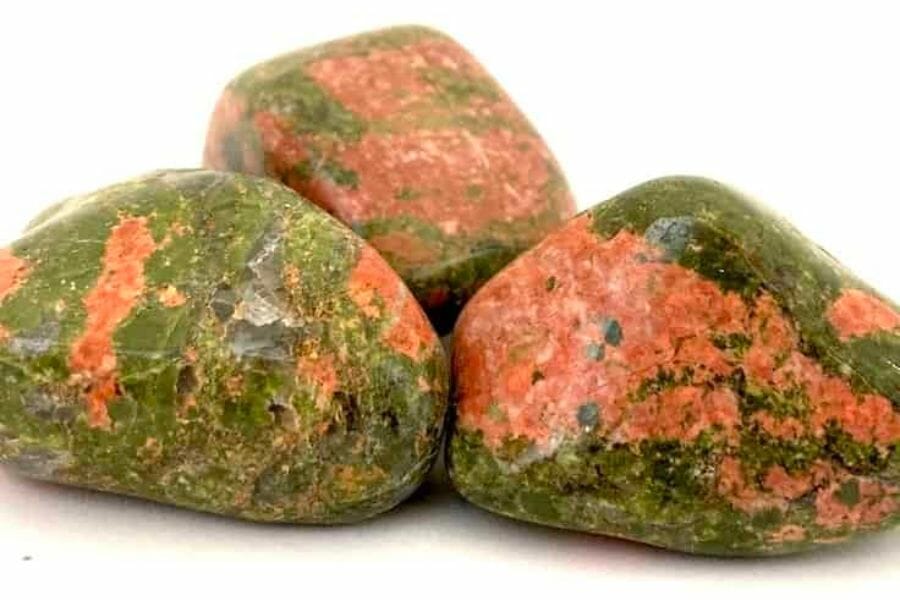
Our recommendations above may not all be very specific, so if you need a little more guidance on where exactly to look, here are the areas that are most-rich in crystals:
Streams and Creeks
The water from streams and creeks is an amazing natural force that can move rocks and minerals from one place to another. Over time, this movement can concentrate certain types of crystals in specific areas, creating excellent opportunities for collectors. Streams and creeks also offer a chance to find specimens that have been freshly exposed by the flowing water. This means you may be able to find crystals that are in excellent condition, without having to dig or excavate.
Road Cuts
Road cuts can be an excellent spot to search for crystals, too. They are sections of rock that have been exposed when a road is cut through a hillside. These sections of rock can reveal valuable minerals and crystals that are otherwise hidden underground.
Mines and Mine Dumps
While these locations might not be as easy to access as streams or road cuts, mines and mine dumps can yield some truly spectacular finds. Mines are underground tunnels or pits that are dug to extract minerals from the earth. Mine dumps, on the other hand, are piles of rock and soil that have been excavated from the mines and discarded on the surface. These piles can contain valuable minerals and crystals that were missed during the mining process.
Tennessee Crystal Mining Laws And Regulations
Collecting crystals in Tennessee is legal for as long as you comply with all local laws related to it, especially those implemented by the Tennessee Department of Environment and Conservation. As a general rule, you need to obtain necessary permits and permission from concerned government offices as well. For private lands, make sure you get the permission of the owner before doing any serious search. By following these local rules and regulations, you are helping make crystal hunting a sustainable activity in our state.
The Best Crystal Shops In Tennessee

Finding crystals in their natural environment takes time, energy, and effort that not everybody has. If you’re one of them, your best chance of taking home a crystal from our state is to visit the local crystal shops here. Here are our top recommended stores with an array of beautiful crystals for you to choose from:
- East Nashville Crystal Store – 804 Meridian St, Nashville, TN 37207
- Stonekeepers – 215 Robert Rose Dr e, Murfreesboro, TN 37129
- Cosmic Connections – 2117 8th Ave S, Nashville, TN 37204
- Jae’s Gem Mine – 2416 Music Valley Dr Suite 102, Nashville, TN 37214
- Chattanooga Crystal Store – 1155 E Main St, Chattanooga, TN 37408
- Stone Harmony – 101 E Main St Suite 101, Gallatin, TN 37066
- Southern Crystal Company – 2215b Old Hickory Blvd, Old Hickory, TN 37138
- Sapphire & Sage – 3249 Gallatin Pike, Nashville, TN 37216
- Crystals & Curiosities – 114 Nashville Hwy, Columbia, TN 38401
- Nashville Crystal Store – 2819 Columbine Pl #7, Nashville, TN 37204
Additional places to find crystals in nearby states
If you’ve already tried all of our recommendations above or are planning a trip out of the state, you should check out our guides for neighboring states:
- Crystals in Kentucky
- Crystals in Virginia
- Crystals in North Carolina
- Crystals in Georgia
- Crystals in Alabama
- Crystals in Mississippi
- Crystals in Arkansas
- Crystals in Missouri
If you have any recommendations we haven’t covered, please leave them in the comments below!

